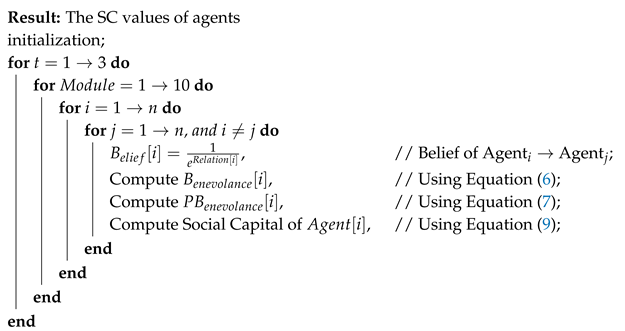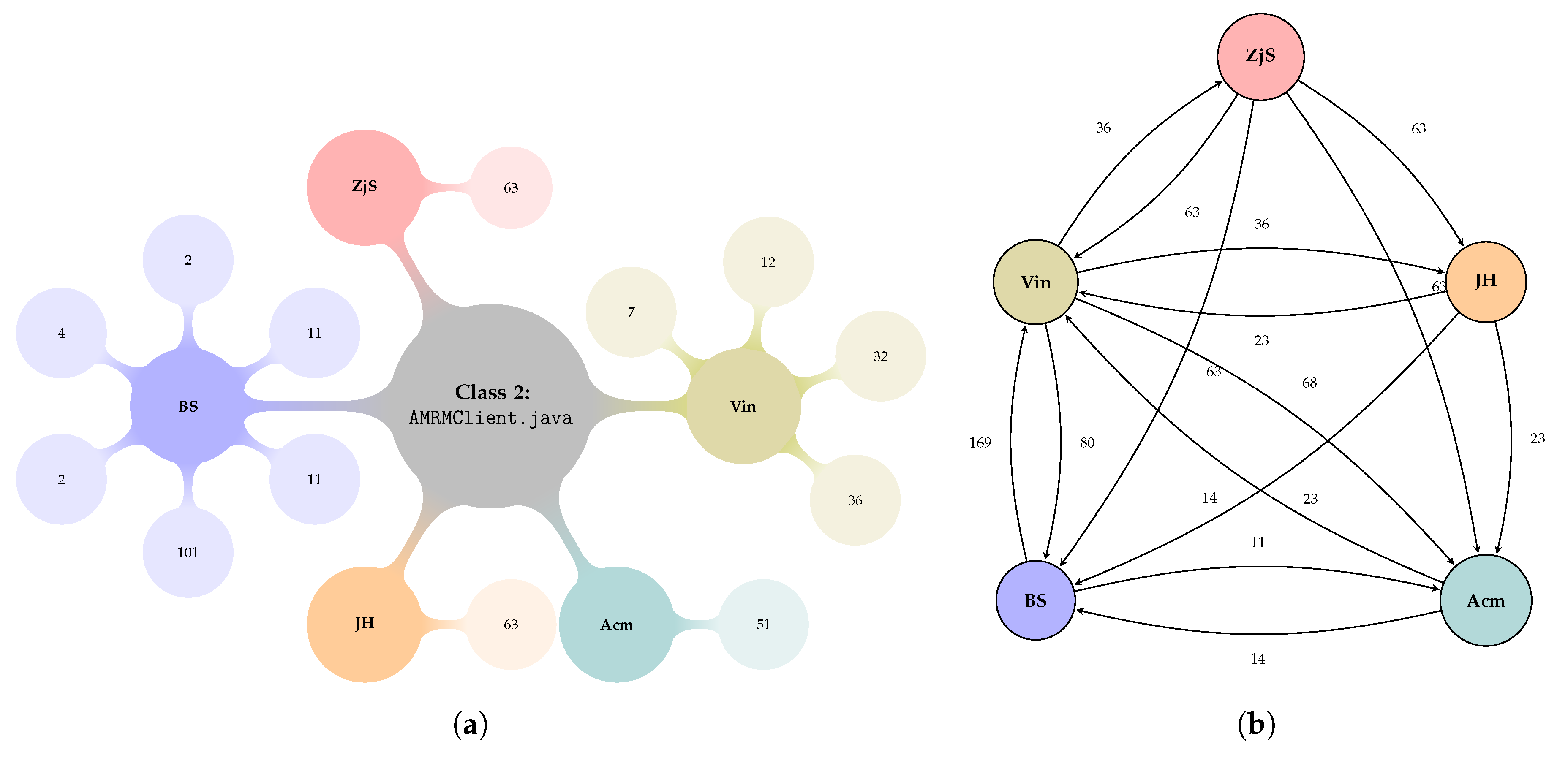We propose a measurement of relations from continual interaction and a quantification of an agent’s capacity before attempting to measure the values of SC.
2.1.1. Relations Measure
In a dynamic organization, agents form subgroups when they tackle different problems for the continuation of their organization. Even though their relations have a huge impact on the formation as well as the coordination in this world, subgroup formation as well as task or problem allocation is outside the scope of this work. We focus on measuring a network of relationships for subsequent determinations of different values that an agent accumulates when interacting with others. The initial values of relations are provided by every agent when she first joins an organization. Those relations and their values are not static and agents are able to create, diminish, or improve each one of them depending on current actions and interaction.
For every action an organization performs, there exists a goal . Each goal will be distributed into a set of tasks, such that , for possible assignments to agents. The completion of one task includes interaction between agents for a set of subtasks . The coordination as well as control of those tasks are determined by the organization. We benefit from the dynamic interaction among agents while achieving multiple tasks in order to update the current values of relations. Those values of relations depends on the nature of interaction over every given task; therefore, we model relations in a task-based scenario to describe the continual changes over time in inter-agent connections and to help with updating relations throughout repeated task assignments. In the case of OSS Project, the goal is to develop the project and the sub-goals are the releases of the project. The tasks are the software modules that need to be developed in order to achieve a sub-goal, i.e., releasing the project. The subtasks of one module are the lines of codes to be added or deleted in order to complete the module. The interaction between agents (contributors) working in a task (module) occur through the completion of the subtasks.
For every self-selected task, agents define a task-based graph upon the initial relations and there is at least one active edge that prescribes a plan. Agents are able to form an edge through successive interaction. In other words, the network structure allows for the property of transitivity, which permits interaction over that edge to improve giving it the chance to reach a threshold in order to be considered active. Interactions are commonly observed of two types of affinities [
3], where (a)
explicit affinities become evident through interaction over an existing relation, i.e., it is observed when two or more agents have interaction with whom they have a previous experience over an existing edge in the graph, and (b)
implicit affinities allow for other possible interaction among agents without previously modeled relations. In the case of OSS Project, explicit affinities between two agents exist when both agents contributed on a common software module. Interactions emerge from the closure property of relations [
33] and may help in forming new edges when updating relations, i.e., previously un-modeled relations.
The current values of relations are updated every time interval
and, in our case, the time interval
t is the time between releases. For the general assembly, we describe existing relations as explicit links; otherwise, they will be considered as implicit. Values of links are proportional to the frequency of interaction over them. The value on an explicit edge,
, between agent
, is computed accumulatively based on the frequency of interaction, i.e.,
I, between the two agents throughout the time interval, i.e.,
. This is stated in Equation (
1) at a specific subtask
, where
is the end of duration that spans from
toward
,
.
Implicit links, i.e.,
, are traditionally observed through triadic closure theory [
34]. Triadic closure, in short, asserts that for each three agents
i,
and
where two explicit affinities exist in terms that link
and
, there should exist an implicit affinity that links
. In a triadic formation of two explicit affinities, there are different possibilities for the value
that the implicit affinity should have. The possible value that an implicit affinity may obtain depends on the value of the current explicit edges. Thus, we can state that the initial value of the third implicit link, i.e.,
, in a triad can be approximated in Equation (
2), which is
.
We are considering the formation of implicit links through explicit links only. That means there must be an explicit path from the source node to target node in order for an implicit link to exist. The traversal in the path of unrepeated explicit links between
i and
will consider the maximum volume despite distances. An extension of the closure envisioned in Equation (
2), where there existed two disjoint, i.e., nonconsecutive, links with explicit affinities or possible undefined links in between, is determined through Equation (
3).
Agents’ interaction are instrumental in forming new implicit links and updating the values of existing explicit ones. During a task completion, it is possible for frequently used implicit relations to gain a sense of actualization; thereby, the implicit relations will be treated the same as explicit ones. Next, we model relations considering those measurements of explicit as well as implicit links. As stated earlier, the initial values of relations are provided by the agents’ public profiles and are used in forming a task-based socio-graph. We mapped those relations into explicit links in a task-based graph in order to capture current interaction as well as to allow possible measures of implicit links. By the time a new task is going to be assigned, an organization updates agents’ relations over all tasks based on the new values of links. When a relation from an implicit link () reaches a threshold value of that has been specified previously by an organization, it will be treated as an explicit one and an agent is able to explicitly form a relation over it. It is possible for those relations to have a value of positive, negative, or mutual (i.e., equal) for non-existing or possible unprejudiced relations.
The relations in the graph are asymmetric relations, so we have to know the temporal direction of those relations. That is, in a tuple
we have to know if the relation direction is from
i to
, i.e.,
, or from
to
i, i.e.,
. Equation (
4) updates the initial value of relation between every pair of agents by considering the most repeated value over an explicit or an implicit link at a given subtask, that is
and
.
2.1.2. Capacity Measure
Agent’s capacity can be described as the absolute ability to accomplish tasks given the time constrains and interests. A measurement of an agent’s capacity is a critical issue and should be addressed once an agent joins an organization. This will eliminate the possibility of agent’s ineligibility to accomplish tasks when allocated to it. The value of capacity is dynamic and rapidly changing from one task to another. For simplicity, we consider capacity to be a combination of an agent’s innate (1)
for the ability to achieve different tasks, extemporaneous (2)
to perform certain actions based on her preferences, and ad-lib (3)
for her readiness to participate. Agents’ capabilities and willingnesses are provided in their public profiles while availabilities are ranging from
based on the task they occupy. Willingness is the degree of commitment to which an agent is ready to work hard to achieve the organizational objectives. The willingness of an agent is important in determining her contributions for a task. Equation (
5) shows a very direct measurement for agent
i’s capacity to achieve a certain task
and that
.
Due to the rapid changes in the agent’s capacity, an agent will not be able to preserve them for future use. They must be updated instantaneously every time a new task is performed. We assume that the capacity of an agent is independent . Along with the presentation of a possible capacity measure, we have proposed a measurement for an agent relations driven from their continual interactions. Those two main parameters needed in determining the values of agents’ unconditional contributions, which are going to be used in the following sections to help in defining measurements of benevolence.
2.1.3. The Value of Benevolence
Agents entering an organization and interacting with those whom they have no previous interaction are initializing their benevolent values with a constant of a Null; then, the benevolences are derived from their relationships with others as well as their capacities to overcome certain problems. Due to the fact that an organization is a formation that overlays a dynamic network, we model benevolence between agents based on a directed network’s graph of connected vertices and edges. The resultant graph will be a task-based weighted graph of vertices as agents capacities and edges as their relations. The weighted benevolent graph is connected, and there should at least be one active relation between any pair of agents. We follow next with a formal definition of the weighted benevolent graph while emphasizing on the parameters that contribute to its value.
Let be a set of agents working on a goal . There exists a set of tasks, i.e., , for each goal. Let , where is a world of N-agents working on , and x is a random variable with distribution that has not been determined yet. The parameters of the are attained from an organization and sampled over existing k-subtasks to all N. Let be the benevolent function of real values that computes the benevolent value of at based on the distribution of k-sub-tasks. We are trying to find out the benevolent values resulting from unilateral relationships between agents of in the .
A benevolent socio-graph is basically a combination of agents and relations. The value of relations can be different from one task to another; however, for the sake of simplicity, we will be evaluating those relations in a task-based graph. We use the normal distribution to correspond to the average values of agents benevolences with a peak and the variability with other agents in a symmetric spread, i.e.,
, where
k is number of subtasks and
is the agent’s capacity
. The benevolence between a pair of agents
can be presented in Equation (
6).
The values of relations are critical in this case, they are resulting from a weighted directed graph of the network. The benevolence takes advantage of agents’ current relations and the rapid changes in their values within the assignment of one task. We take into consideration an agent current interests and readiness to contribute captured in the measurement of capacity. Although implicit links are not considered when defining benevolence, current values of relations have already considered them, and they will directly contribute to current values of benevolence once a specific threshold is reached.









